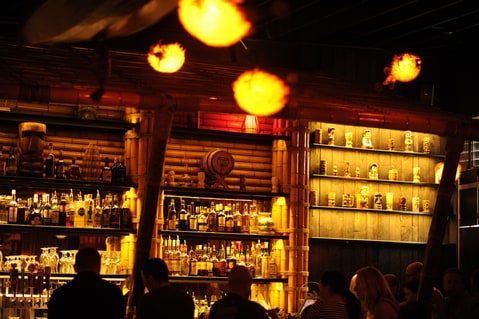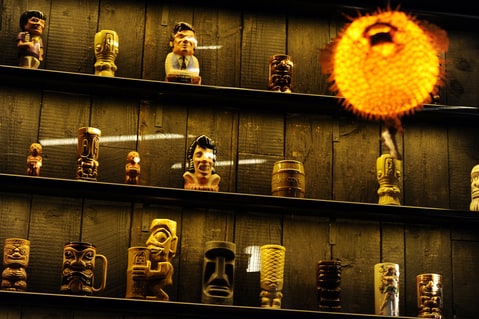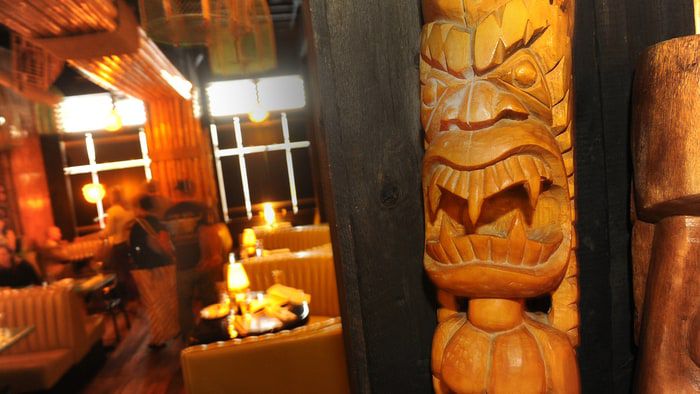Who Invented the Tiki Bar? A Brief (and Controversial) History
Tiki bars are about as authentic to the South Pacific as fortune cookies are to China. But whether they appear as high-brow clubs or divey haunts, they represent the same thing: Escape — both from city life and, almost unavoidably, sobriety. At a tiki bar you can get an Easter Island head full of juice and high-proof rum from a bartender in a Hawaiian shirt. It's nonsense, albeit the fun kind. And just like its interior, the tiki bar's history is a hodgepodge: barstool stories and drunk history, making its true origins difficult to pin down. But we’ll give it a shot anyway.
MORE: The Tiki Cocktail Revival
It All Started With One Man’s Yearning for the South Pacific (Probably)
Ernest Raymond Beaumont Gantt, known better as Don the Beachcomber, is often called the founding father of tiki. Don was a bootlegger and spent many of his young years touring the South Pacific for inspiration. By the time he returned to the states in 1934, he brought back vast knowledge of exotic landscapes: bamboo, pineapples, Polynesian mythology, and, maybe most important, rum.
Don opened up a bar in L.A. during 1934 called — what else? — Don the Beachcomber, and started the tiki movement. The hangouts in Hawaii were a far cry from the ways he remembered, and were more like napkin drawings of everything the owners liked about Polynesian culture — not necessarily spot-on depictions.
ALSO: Tiki Cocktail Recipes That Don't Suck
“Tiki bars started in America — they do not emanate from bars in the South Pacific or the Caribbean,” says Martin Cate, author of Smuggler's Cove: Exotic Cocktails, Rum, and the Cult of Tiki. “They were an attempt to re-create the sense of escape and paradise of the islands on American soil.”
But Don sought authenticity. So he began collecting refuse from the beach with a neighbor named Eli Hedley, looking for bamboo, trinkets, masks — whatever they could find to make Don’s bar look more like the islands that influenced the movement. It worked: Tiki bars today are still decorated with old fishing nets, driftwood, and orphaned wharf ephemera.
“The Americans kind of got ahold of their culture, put it in a blender, and mixed it all up,” says Hedley’s grandson, ‘Bamboo’ Ben Bassham. “People were coming back from World War II, liked what they saw, and put two and two together.”
 Adrift tiki bar in Denver, Colorado
Getty Images
Adrift tiki bar in Denver, Colorado
Getty Images
Then Came the Exotic Drinks (and the Fights)
The problem with nailing down a drunk movement’s history is figuring who really invented what. After all, the Mai Tai, a staple rum drink at just about any tiki bar you could visit, could either have been invented in 1944 by Victor Bergeron, founder of Trader Vic’s, or by Don back in 1933. "Anybody who says I didn't create this drink is a dirty stinker," Bergeron said, according to a 1994 New York Times article. Same goes for whether it was Don or Bergeron who introduced the pu-pu platter, a meaty appetizer spread accompanied by a hibachi grill.
“Don the Beachcomber made the first Zombie,” says Bassham of the night-ruining 151-proofed rum drink. “Trader Vic stole it from him. He switched a couple ingredients and called it a Mai Tai. Story goes like this: guy walks into his bar hungover and said, ‘Make me something strong, I feel like a zombie right now.’ Don the Beachcomber just started throwing stuff into the glass and gave it to the guy, and that’s how the Zombie was born.”
 A collection of tiki mugs
Getty Images
A collection of tiki mugs
Getty Images
A 30-year Decline
After the ‘50s, tiki bars fell out of vogue. The ‘60s, ‘70s, and ‘80s were tragically bereft of pineapple juice hangover omens. Drinking out of a monkey skull just wasn’t cool anymore.
Why? Maybe it was Vietnam, or changing tastes. Maybe a generational shift to the Boomers who got their kicks from drugs, not exotic cocktails, or art critics decrying it as tacky. People just realized they didn’t want what they had created.
Fortunately, the aughts saw a resurgence. More monkey skulls. More Easter Island heads. Much, much more rum. Tiki bars reared their wooden masks for the same reason they came into vogue in the first place: Escapism, and the rekindled love of alcohol as something more compelling than a two-ingredient social lubricant.
“I think the broader cocktail revival has much to do with tiki’s resurgence, too,” says the New York Times’ Rosie Schaap. “People have come to appreciate a cocktail as a small-scale event, and are willing to wait a few minutes more for something special, made with good ingredients and with care. But a nice difference with tiki… is that in the tiki ethos, there’s no place for any of the sanctimoniousness sometimes found elsewhere in cocktail culture.”
Now, decades after the tiki bar's first bout of popularity, disagreements about who did what where and when in its history still haven't been proven. But maybe that's the beauty of the genre: If your crowd isn't uptight, shouldn't your origin story be the same? Tiki bars, regardless of their beginnings, accomplished what they set out to do. They're thoughtful about booze without being obnoxious. They occupy a sweet spot between punk rock dives and cleaned-up clubs. They’re serious about not being serious — or at very least, they’re serious about getting you drunk. And if you’re trying to escape, what else do you need?
